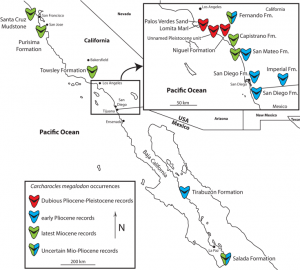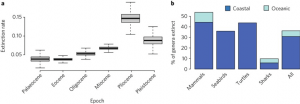Guest Author: Jack Cooper, MSc
UoB Graduate / PhD Student, University of Swansea
And so we come to the end of Megalodon’s supremacy in the Cenozoic oceans. It had a good run for sure (~20 million years), but unfortunately all good things come to an end. While everything about Megalodon is cool and warrants research attention (why do you think I ended up with 7 blog posts?), a key question of its recent science is when the last of these giant sharks finally died, leaving only its teeth as its legacy.
There’s a very basic rule in palaeontology that the youngest dated fossil of a species does not necessarily represent the last ever individual. It’s the fossil equivalent of assuming a modern species is extinct because they haven’t been sighted for a few years. This is because the fossil record is inherently incomplete.
Not every dead animal is lucky enough to become fossilised. Complex analyses therefore often have to be used to give a rough estimation of when a species died out, especially considering that fossils are dated within a range rather than an exact age. One model that has been shown to be fairly accurate is Optimal Linear Estimation (OLE) [1]. This uses a temporal distribution of recent species sightings (or in this case, fossil occurrences) to estimate a time when the species may have gone extinct. While it can provide a wide range of proposed extinction times, simulating this model multiple times can reveal a modal value, which is the time most frequently inferred. This is a more accurate value than an average, as it considers the skewed distribution that fossil occurrences are likely to have since we may, for example, find more fossils from the Miocene than the Pliocene.
By 2013, the work of Christopher Clements [2] had shown that this model could be accurately used for species that are disappearing today. Catalina Pimiento quickly jumped on this and teamed up with Clements to make a novel use of this model – gathering the most recent fossil occurrences of Megalodon to estimate when it went extinct [3]. The two gathered all known post-Miocene Megalodon occurrences from the Palaeobiology Database (PBDB) and the literature, studying the geological data of their occurrences and visiting museums housing them to verify the ages and reliability of these fossils. These data were resampled 10,000 times to account for the uncertainty of fossil ages. By applying the OLE model to these occurrences, Pimiento and Clements obtained a modal value of 2.6 million years ago (Ma). The oldest inferred extinction date came to ~3.5 Ma, with half the simulations producing extinction times between this and 2.6 Ma. The other half were evenly distributed across a longer time frame of 2.6 Ma to the present, with 6 simulations timing Megalodon’s extinction as after the present day (Fig. 1). As such, they concluded that Megalodon was extinct by 2.6 Ma [3].


Regardless of the exact Pliocene date when Megalodon literally bit the dust, these same scientists have also looked into how it happened. One theory you’re likely to come across in internet comment sections is that climate changes occurring as the planet got closer to the ice age decreased water temperatures, becoming too cold for the giant shark to cope. The work of Pimiento and Ferrón strongly debunks this. When analysing Megalodon’s global distribution through time, Pimiento found that Megalodon was well capable of inhabiting colder latitudes and its distribution through time did not correlate with any warming or cooling temperature trends known to the Miocene and Pliocene [7]. This finding connects well to Ferrón’s suggestion that Megalodon was likely a mesotherm and thus able to occupy a wider range of temperature niches [8]. It is therefore far more likely that a biotic factor was responsible for the shark’s demise.
Instead, Pimiento’s analyses found that Megalodon’s global abundance and distribution peaked in the Miocene, before going into decline near the end of this epoch [7]. This correlates with a huge diversity decline in cetaceans, Megalodon’s favourite food [9]. As this occurred, Megalodon was likely forced to compete harder for those that remained. Some of its competitors included raptorial sperm whales [10], however Boessenecker and colleagues noted that these species went extinct before Megalodon [6]. But there was another, smaller, shark beginning to emerge at this time: Jaws himself, the great white shark [6,7]. While there isn’t any direct evidence that these sharks competed with one another, both Megalodon and the great white’s ancestor Carcharodon hubbelli have been found in Peru’s Pisco formation [11]. Boessenecker and his team also suggest that perhaps the evolution of the great white, a smaller shark that needed to eat a lot less food than Megalodon and could eat the same small whales, was a driving force in Megalodon’s extinction [6]. However, they note that white shark fossils appear to be present in the Pacific Ocean before the Atlantic Ocean. Could this mean that Megalodon vanished from the Pacific Ocean earlier than from other areas? Possibly, but more data is needed to have a better idea of this.
Megalodon’s disappearance certainly seems to correlate with declines of small-sized baleen whales, its likely prey [3,9,12]. However, changes in sea level may have also altered their habitats. Sea level fluctuations were common during the Pliocene, and may have been bad news for a giant shark if they affected its nursery areas or coastal habitats where there’s a lot of available food. Examining the Pliocene marine fossil record, a team led by Pimiento found that extinction rates of marine megafauna (the largest genus or species of a particular group of animals) were incredibly high in the Pliocene (Fig. 3). Among those lost included 55% of large marine mammals, 43% of sea turtles and 9% of sharks, with a total of 36% of large marine species going extinct (Fig. 3). This marks a clear marine megafaunal extinction event [13]. Perhaps Megalodon was also caught up in this. Further analysis suggested that endotherms were particularly at risk, due to declines in food availability. Megalodon may therefore have been too large to sustain itself on a reduced diet. However, if the results of Boessenecker’s team are to be believed, then Megalodon may have already been gone by the time these extinctions occurred [6].

References
- Solow AR 2005. Inferring extinction from a sighting record. Math. Biosci. 195, 47-55.
- Clements CF, Worsfold NT, Warren PH, Collen B, Clark N, Blackburn TM & Petchey OL 2013. Experimentally testing the accuracy of an extinction estimator: Solow’s optimal linear estimation model. J. Anim. Ecol. 82, 345-354.
- Pimiento C & Clements CF 2014. When did Carcharocles megalodon become extinct? A new analysis of the fossil record. PLoS One 9, e111086.
- Boessenecker RW 2013. A new marine vertebrate assemblage from the Late Neogene Purisima Formation in Central California, part II: Pinnipeds and Cetaceans. Geodiversitas 35, 815-940.
- Boessenecker RW 2016. First record of the megatoothed shark Carcharocles megalodon from the Mio-Pliocene Purisima Formation of Northern California. PaleoBios 33, 1-7.
- Boessenecker RW, Ehret DJ, Long DJ, Churchill M, Martin E & Boessenecker SJ 2019. The Early Pliocene extinction of the mega-toothed shark Otodus megalodon: a view from the eastern North Pacific. PeerJ 7, e6088.
- Pimiento C, MacFadden BJ, Clements CF, Varela S, Jaramillo C, Velez‐Juarbe J & Silliman BR 2016. Geographical distribution patterns of Carcharocles megalodon over time reveal clues about extinction mechanisms. J. Biogeogr. 43, 1645-1655.
- Ferrón HG 2017. Regional endothermy as a trigger for gigantism in some extinct macropredatory sharks. PLoS one, 12, e0185185.
- Marx FG & Uhen MD 2010. Climate, critters, and cetaceans: Cenozoic drivers of the evolution of modern whales. Science, 327, 993-996.
- Lambert O, Bianucci G, Post K, De Muizon C, Salas-Gismondi R, Urbina M & Reumer J 2010. The giant bite of a new raptorial sperm whale from the Miocene epoch of Peru. Nature, 466, 105-108.
- Ehret DJ, MacFadden BJ, Jones DS, Devries TJ, Foster DA & Salas-Gismondi R 2012. Origin of the white shark Carcharodon (Lamniformes: Lamnidae) based on recalibration of the Upper Neogene Pisco Formation of Peru. Palaeontology, 55, 1139-1153.
- Collareta A, Lambert O, Landini W, Di Celma C, Malinverno E, Varas-Malca R, Urbina M & Bianucci G 2017. Did the giant extinct shark Carcharocles megalodon target small prey? Bite marks on marine mammal remains from the late Miocene of Peru. Palaeogeogr. Palaeoclimatol. Palaeoecol. 469, 84-91.
- Pimiento C, Griffin JN, Clements CF, Silvestro D, Varela S, Uhen MD & Jaramillo C 2017. The Pliocene marine megafauna extinction and its impact on functional diversity. Nat. Ecol. Evol. 1, 1100-1106.
Edited by Rhys Charles

